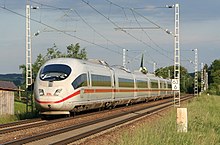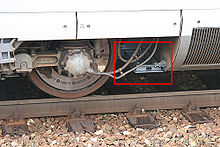ICE 3
| DB/NS Class 403/406/407 | |
|---|---|
 ICE 3 on the Cologne–Frankfurt high-speed rail line | |
| In service | 2000 - |
| Manufacturer | Siemens |
| Family name | Velaro |
| Number built | 50 trainsets (ICE 3) 17 trainsets (ICE 3M/F) |
| Formation | 8 passenger cars per halftrain, optional double traction giving 16 passenger cars |
| Capacity | 441 (ICE 3) 430 (ICE 3M) |
| Operators | Deutsche Bahn Nederlandse Spoorwegen |
| Specifications | |
| Width | 2950 mm (ICE 3/ICE 3M) 3265 mm (Velaro D) |
| Maximum speed | 180 km/h (110 mph) (service) |
| Weight | 409 t (ICE 3) 435 t (ICE 3M) |
| Electric system(s) | 15 kV AC 1.5 kV DC (ICE 3M) 3 kV DC (ICE 3M/Velaro D) 25 kV AC (ICE 3M/F/Velaro D) |
| Safety system(s) | Sifa, PZB90, LZB (ICE 3) Sifa, PZB90, LZB80, Crocodile, TVM430, KVB, ATB, Eurobalise (ICE 3M) |
| Track gauge | Standard gauge - 4 ft 8.5 in (1.435 m) |
ICE 3 is a family of high-speed EMUs of Deutsche Bahn. It includes classes 403 and 406, which are known as ICE 3 and ICE 3M respectively. Four multisystem trains, known as ICE International, are owned by Nederlandse Spoorwegen (Dutch Railways).
Loosely based on the ICE 3, Siemens developed its Siemens Velaro after the completion of the ICE 3 project; these trains will enter service as class 407 in late 2011.
Class 403

The design goal of the ICE 3 (Class 403) was to create a higher-powered, lighter train than its predecessors. This was achieved by distributing its 16 traction motors underneath the whole train. The train is licensed for 330 km/h (205 mph) and has reached 368 km/h (228.68 mph) on trial runs. On regular InterCityExpress services they run at up to 300 km/h (186 mph), the maximum design speed of German high-speed lines.
Because the train does not have powerheads, the whole length of the train is available for passenger seats, including the first car. The so-called lounge-seats are located directly behind the driver, separated only by a glass wall.
Early versions of the ICE 3 were in service as early as 1999 and tests were conducted between Frankfurt-Munich in configurations that were abandoned later, e.g. bicycle racks towards the end of the train.
Class 406


The ICE 3M (Class 406; M for multisystem) was developed to operate services Europe wide under the four different Railway electrification systems in use on Europe's main lines and with support for various train security systems. The Deutsche Bahn (DB) ordered 13 of those units in 1994, the NS (Nederlandse Spoorwegen), four, making sure that the demands of the Dutch rail network are taken care of. Though these trains carry NS logos, the DB and NS trains together form a pool and therefore the NS trains may operate DB services also. As of 2007, the train is licensed for operation in the Netherlands, Belgium and France. Currently those trains are used for cross-border runs between Netherlands, Germany, Belgium and France. On the French LGV Est some trains reach a regular top speed of 320 km/h (200 mph).
In Belgium, the train was licensed in 2002 to run on the classic 3 kV DC lines with speeds up to 160 km/h and, from December 2004 on, also on the new high speed lines, but initially limited to 250 km/h instead of 300 km/h.[1] Problems with flying gravel and its frictionless linear eddy current brake came up during testing. In order to limit the creation of tornado-like vorticles that pick up gravel and to limit damage from flying gravel to the train, spoilers have been added under the car joints, under the carbody next to the bogies and under the powered axles on the bogies.

The linear eddy current brake, which is required for higher speeds, cannot yet be used, because the magnetic field would rip off the magnetic covers of some trackside equipment; those covers will have to be replaced by non-magnetic ones according to the EU Technical Specifications for Interoperability for international rail traffic in Europe.
As in Belgium, licensing procedures for France took five years to be completed. Trial runs were completed in late 2005 and the same two problems were encountered as in Belgium: loose gravel damage and possible side-effects of the brakes. However, ICE 3Ms were allowed on the LGV Est and started service there on 20 June 2007, mixed with TGVs. Since December 2007, DB operates ICE 3M trains from Frankfurt Hbf to Paris Est, initially with five daily runs between both cities. The trains for running into France (called ICE-3 MF, indicating multisystem France) were modified at Bombardier's Hennigsdorf plant and were extensively tested on Siemens' test site in Wegberg-Wildenrath before the modified trains re-entered commercial service.
In Switzerland, licensing took only six months.[1] However, the train lost its Swiss licence in 2006 when the ZUB and Integra safety systems were removed, which interfered with the French safety systems TVM430 and KVB. This was not a significant setback, however, as the Amsterdam-Basel service was the sole presence in Switzerland.
Class 407


Deutsche Bahn placed an order for fifteen trains valued €500 million in November 2008.[2] On 18 April 2010 Deutsche Bahn presented the first Velaro D at Siemens' Krefeld plant.[3] It is designed for operation at up to 320 km/h, is wider, quieter and more energy-saving, should be less susceptible to malfunctions than its predecessor, and incorporates additional crashworthiness and fire safety measures.[3] At the end of 2011 the new train will enter service, designated as Class 407 or new ICE 3: it will be used mainly for international connections from Germany to France, Belgium and the Netherlands.[4] However, the new type's safety measures are in line with the new specifications for operating passenger trains inside the Channel Tunnel, which would allow the Class 407 to potentially operate to the United Kingdom.
References
- ^ a b Harmonisierungsdefizite am Beispiel von Auslandszulassungen des Triebzuges ICE 3, in "Elektrische Bahnen", Vo. 103 (2005), pages 147-149
- ^ "Siemens receives order over 15 high-speed trains from Deutsche Bahn". Siemens. 2008-12-17. Retrieved 2008-12-27. Reference Number: I MO 200812.006-04.
- ^ a b "DB unveils next-generation ICE". Railway Gazette International. 2010-04-28. Retrieved 2010-05-04.
- ^ "Neuer ICE: Hightech gegen die Achsenkrise" (in German). Spiegel Online. 2010-04-28. Retrieved 2010-04-28.
External links
- ICE 3 for Germany and the Netherlands Siemens Page
